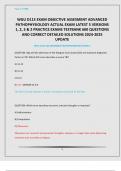Page 1 of 560
WGU D115 EXAM OBJECTIVE ASSESMENT ADVANCED
PATHOPHYSIOLOGY ACTUAL EXAM LATEST 5 VERSIONS
1, 2, 3 & 2 PRACTICE EXAMS TESTBANK 600 QUESTIONS
AND CORRECT DETAILED SOLUTIONS 2024-2025
UPDATE
WGU D115 OA ADVANCED PATHOPHYSIOLOGY EXAM 1
QUESTION: Age and the admission of the Glasgow Coma Scale (GCS) are important diagnostic
factors in TBI. Which GCS score describes a severe TBI?
A) 13-15
B) 12-13
C) 9-12
D) 3-8 - ANSWER-D) 3-8
The GCS is scored between 3 and 15, 3 being the worst and 15 the best.
QUESTION: Which term describes recurrent, intrusive thoughts or impulses?
A) Hallucinations
B) Compulsions
C) Obsessions
Obsessions are recurrent and persistent thoughts, impulses, or images that cause distressing
emotions such as anxiety or disgust.
1
,Page 2 of 560
D) Delusions - ANSWER-C) Obsessions
Obsessions are recurrent and persistent thoughts, impulses, or images that cause distressing
emotions such as anxiety or disgust.
QUESTION: During an intake interview with a 26-year-old man diagnosed with generalized
anxiety disorder, the FNP might observe what type of behavior?
A) An inflated sense of self
B) Constant relation to future events
C) Inability to concentrate and irritability when questioned
Impaired concentration and irritability are major characteristics of GAD.
D) Nervousness and fear of the FNP during the interview - ANSWER-C) Inability to concentrate
and irritability when questioned
Impaired concentration and irritability are major characteristics of GAD.
QUESTION: The FNP would expect which symptoms in a patient with a diagnosis of
schizophrenia?
A) High energy with varying sleep patterns and non stop conversation.
B) Extreme and frequent mood swings with hyperactivity and difficulty concentrating.
C) Paranoia, delusions, hallucinations, and diminished self-care.
D) Anti-social behavior, manipulative behavior, charisma, and ability to lie convincingly. -
ANSWER-C) Paranoia, delusions, hallucinations, and diminished self-care.
2
,Page 3 of 560
The characteristics of schizophrenia are paranoia, delusions, tangential thoughts,
suspiciousness, disorganized behavior, and hallucinations.
QUESTION: The FNP is seeing a 10 year old child with complaints of otalgia and muffled hearing.
The mother states the child recently recovered from an upper respiratory infection. The FNP
suspects that this child has:
A) Acute otitis media
B) Acute otitis externa
C) Cholesteatoma
D) Chronic otitis media - ANSWER-A) Acute otitis media
The classic presentation of otitis media is otalgia, muffled hearing, popping sensation, and a
recent history of a cold or flare up of allergic rhinitis.
QUESTION: The FNP understands that a potential complication of tonsillar infections, which is
characterized by severe sore throat, difficulty swallowing, odynophagia, trismus, and a "hot
potato" voice; accompanied by fever, chills and malaise is indicative of:
A) Retropharyngeal abscess
B) Epiglotitis
C) Peritonsillar cellulitis
D) Peritonsillar abscess - ANSWER-D) Peritonsillar abscess
3
, Page 4 of 560
Peritonsillar abscess is characterized by severe sore throat, pain or difficulty swallowing, jaw
muscle spasms, and a hot potato voice.
QUESTION: A young adult female patient presents to the clinic with complaints of nervousness,
tremulousness, palpitations, heat intolerance, fatigue, weight loss, and polyphagia. After a
complete history and physical, along with thyroid function tests, the FNP makes the diagnosis of
hyperthyroidism, recognizing that the most common cause of this condition is:
A) Thyroid cancer
B) Graves' disease
C) Pituitary adenoma
D) Postpartum thyroiditis - ANSWER-B) Graves' disease
Graves' disease, an autoimmune condition also known as "diffuse toxic goiter" is the most
common cause of hyperthyroidism in this age group.
QUESTION: During an evaluation of a patient with prediabetes, the FNP identifies which finding
in the patient's objective data that is associated with the increasing insulin resistance?
A) Triglycerides > 150mg/dL
B) HDL > 40 mg/dL in men and >50 mg/dL in women
C) BP < 130/85 mm Hg
D) FBS < 110 mg/dL - ANSWER-A) Triglycerides > 150mg/dL
Improper use of glucose increases the release of free fatty acids which elevates triglycerides.
4




